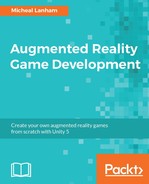If you have already covered a couple of chapters in this book, you may be familiar with CUDLR, which is an excellent remote logging, debugging, and inspection tool. For those of you that missed the CUDLR setup in Chapter 2, Mapping the Player's Location, no worries, as we will do a review of the setup here. Of course, if you are here because of issues with CUDLR, refer to the final section in this chapter, Issues and Solutions by Chapter.
CUDLR is a remote console that runs through an internal web server created within your game. It uses the same technique we used to output the log output, but it also provides for object inspection and even customization. Use the following instructions to set up CUDLR (if you have already done this, you may want to just skim over this section):
- If you have not already set up the
Chapter 10project, then open a new Unity project and importChapter10.unitypackagefrom theChapter_10_Assetsfolder of the books downloaded source code. - Open the Main scene from the
Assets/Chapter 10/Scenesfolder. - From the menu, select GameObject | Create Empty. Rename the object
CUDLRand reset its transform to zero. - Drag the
Serverscript from theAssets/CUDLR/Scriptsfolder in the Project window onto the newCUDLRGameObject. - By default,
CUDLRsets itself to run on port55055. This setting can be changed by inspecting theCUDLRGameObject in the Inspector window. For now though, leave it at the default value. - Press Play in the editor to run the scene. Keep the scene running.
- Open the browser of your choice and enter the following URL:
http://localhost:550555 - The CUDLR window will open in the browser, as shown in the following screenshot:

CUDLR window in a browser (Chrome)
- At the bottom of the window, enter the following command:
help - This will provide the following output:
Commands: object list : lists all the game objects in the scene object print : lists properties of the object clear : clears console output help : prints commands
- Enter the following command:
object list - This gives the following output:
CUDLR Directional Light Cube Main Camera
- Enter the following command:
object print Cube - This gives the following output:
Game Object : Cube Component : UnityEngine.Transform Component : UnityEngine.MeshFilter Component : UnityEngine.BoxCollider Component : UnityEngine.MeshRenderer Component : RotateObject
As we have shown in several sections of this book, CUDLR is also useful for capturing logging activity on a game running on a mobile device. With CUDLR, you could simultaneously track logging output on several devices at the same time. Of course, CUDLR is really only intended for capturing logs while debugging or testing. The internal web server CUDLR creates is not something we would want to ship with our game for numerous reasons.
What if we want to track critical error or exception logs after our game is released? Fortunately, there are a number of options available to do that in Unity and we will look at one of these options in the next section.
